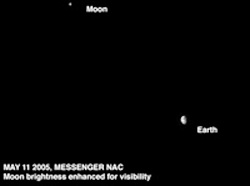Messenger peeks at Earth

The Earth and moon from 18 million miles away, as seen by the MESSENGER space probe.
Mercury-bound NASA probe snaps first approach shots before August flyby
NASA’s Mercury-bound MESSENGER spacecraft — less than three months from an Earth flyby that will slingshot it toward the inner solar system — successfully tested its main camera by snapping distant approach shots of Earth and the Moon.
MESSENGER took a set of six pictures on May 11 with the narrow-angle camera in its Mercury Dual Imaging System, or MDIS. Earth was about 18.4 million miles (29.6 million kilometers) from MESSENGER at the time, but the main processed image clearly shows bands of clouds between North and South America on Earth’s sunlit side. The image, available on the Web at http://messenger.jhuapl.edu, is cropped from the full MDIS image size of 1024×1024 pixels, and the contrast has been adjusted slightly to bring out the Moon in the same frame. The Moon was 248,898 miles (400,563 kilometers) from Earth.
Dr. S. Edward Hawkins III, lead engineer for MDIS at the Johns Hopkins University Applied Physics Laboratory (APL) in Laurel, Md., said finding the Moon in the pictures was an unexpected bonus. “As we stretched the image we saw this little object to the side, which turned out to be the Moon,” he said. “That was exciting.”
One of seven instruments in MESSENGER’s science payload, the multispectral MDIS has wide- and narrow-angle imagers, both based on charge-coupled devices (CCDs) found in common digital cameras. MDIS has taken nearly 400 test shots since MESSENGER launched from Cape Canaveral Air Force Station last Aug. 3, but all were of star fields, dark space or a calibration target on MESSENGER’s lower deck. “The team is elated,” says Dr. Louise M. Prockter, MDIS instrument lead scientist at APL. “These were our first ’real’ images, and they’re only going to get better as MESSENGER moves closer to Earth.”
The photo session was just part of the preparations for the Aug. 2 Earth flyby, the first major adjustment to MESSENGER’s flight path toward Mercury. While MDIS took its pictures, the Mercury Laser Altimeter team at NASA’s Goddard Space Flight Center in Maryland checked its instrument’s alignment by firing a high-powered laser at it from a ground-based Goddard telescope. The mission operations and science teams are also finalizing plans to calibrate several instruments – including the Magnetometer, Energetic Particle and Plasma Spectrometer, and Mercury Atmospheric and Surface Composition Spectrometer – during approach and departure observations of Earth and the Moon. Closest approach will bring MESSENGER 1,458 miles (2,347 kilometers) over northern Asia; observers with small telescopes in Japan, Eurasia and Africa will have the best chance to spot the spacecraft.
During a 4.9-billion mile (7.9-billion kilometer) journey that includes 15 trips around the Sun, MESSENGER will fly past Earth once, Venus twice and Mercury three times before easing into orbit around its target planet. The upcoming Earth flyby and the Venus flybys, in October 2006 and June 2007, will use the pull of the planets’ gravity to guide MESSENGER toward Mercury’s orbit. The Mercury flybys in January 2008, October 2008 and September 2009 help MESSENGER match the planet’s speed and location for an orbit insertion maneuver in March 2011. The flybys also allow the spacecraft to gather data critical to planning a yearlong orbit phase.
MESSENGER, short for MErcury Surface, Space ENvironment, GEochemistry, and Ranging, is the seventh mission in NASA’s Discovery Program of lower cost, scientifically focused exploration projects. Dr. Sean C. Solomon, of the Carnegie Institution of Washington, leads the mission as principal investigator. APL manages the mission for NASA, built MESSENGER and operates the spacecraft.
Media Contact
More Information:
http://www.jhuapl.eduAll latest news from the category: Physics and Astronomy
This area deals with the fundamental laws and building blocks of nature and how they interact, the properties and the behavior of matter, and research into space and time and their structures.
innovations-report provides in-depth reports and articles on subjects such as astrophysics, laser technologies, nuclear, quantum, particle and solid-state physics, nanotechnologies, planetary research and findings (Mars, Venus) and developments related to the Hubble Telescope.
Newest articles

High-energy-density aqueous battery based on halogen multi-electron transfer
Traditional non-aqueous lithium-ion batteries have a high energy density, but their safety is compromised due to the flammable organic electrolytes they utilize. Aqueous batteries use water as the solvent for…

First-ever combined heart pump and pig kidney transplant
…gives new hope to patient with terminal illness. Surgeons at NYU Langone Health performed the first-ever combined mechanical heart pump and gene-edited pig kidney transplant surgery in a 54-year-old woman…

Biophysics: Testing how well biomarkers work
LMU researchers have developed a method to determine how reliably target proteins can be labeled using super-resolution fluorescence microscopy. Modern microscopy techniques make it possible to examine the inner workings…





















